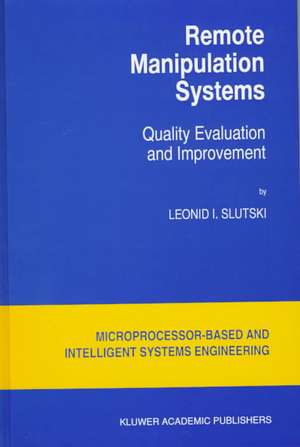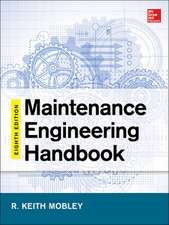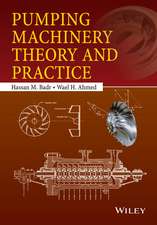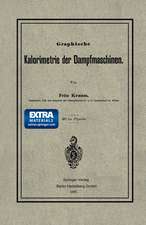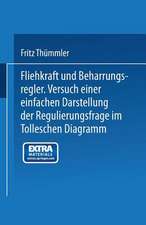Remote Manipulation Systems: Quality Evaluation and Improvement: Intelligent Systems, Control and Automation: Science and Engineering, cartea 17
Autor L.I. Slutskien Limba Engleză Hardback – 30 noi 1997
| Toate formatele și edițiile | Preț | Express |
|---|---|---|
| Paperback (1) | 942.01 lei 6-8 săpt. | |
| SPRINGER NETHERLANDS – 16 oct 2012 | 942.01 lei 6-8 săpt. | |
| Hardback (1) | 947.98 lei 6-8 săpt. | |
| SPRINGER NETHERLANDS – 30 noi 1997 | 947.98 lei 6-8 săpt. |
Din seria Intelligent Systems, Control and Automation: Science and Engineering
- 18%
 Preț: 890.23 lei
Preț: 890.23 lei - 24%
 Preț: 672.00 lei
Preț: 672.00 lei - 18%
 Preț: 951.59 lei
Preț: 951.59 lei - 15%
 Preț: 647.27 lei
Preț: 647.27 lei - 15%
 Preț: 644.63 lei
Preț: 644.63 lei - 18%
 Preț: 1246.15 lei
Preț: 1246.15 lei - 18%
 Preț: 1011.45 lei
Preț: 1011.45 lei - 20%
 Preț: 752.66 lei
Preț: 752.66 lei - 18%
 Preț: 1230.66 lei
Preț: 1230.66 lei - 18%
 Preț: 1839.32 lei
Preț: 1839.32 lei - 18%
 Preț: 719.59 lei
Preț: 719.59 lei - 15%
 Preț: 636.12 lei
Preț: 636.12 lei - 18%
 Preț: 1112.15 lei
Preț: 1112.15 lei - 18%
 Preț: 1836.31 lei
Preț: 1836.31 lei - 18%
 Preț: 1236.51 lei
Preț: 1236.51 lei - 20%
 Preț: 988.81 lei
Preț: 988.81 lei - 20%
 Preț: 357.15 lei
Preț: 357.15 lei - 15%
 Preț: 640.71 lei
Preț: 640.71 lei - 18%
 Preț: 1835.83 lei
Preț: 1835.83 lei - 18%
 Preț: 962.98 lei
Preț: 962.98 lei - 15%
 Preț: 643.48 lei
Preț: 643.48 lei - 18%
 Preț: 951.47 lei
Preț: 951.47 lei - 18%
 Preț: 950.84 lei
Preț: 950.84 lei - 20%
 Preț: 1924.47 lei
Preț: 1924.47 lei - 15%
 Preț: 644.30 lei
Preț: 644.30 lei - 20%
 Preț: 556.64 lei
Preț: 556.64 lei - 18%
 Preț: 952.72 lei
Preț: 952.72 lei - 18%
 Preț: 953.97 lei
Preț: 953.97 lei - 18%
 Preț: 951.14 lei
Preț: 951.14 lei
Preț: 947.98 lei
Preț vechi: 1156.07 lei
-18% Nou
Puncte Express: 1422
Preț estimativ în valută:
181.39€ • 189.39$ • 150.13£
181.39€ • 189.39$ • 150.13£
Carte tipărită la comandă
Livrare economică 04-18 aprilie
Preluare comenzi: 021 569.72.76
Specificații
ISBN-13: 9780792348221
ISBN-10: 0792348222
Pagini: 219
Ilustrații: XIX, 219 p.
Dimensiuni: 170 x 244 x 14 mm
Greutate: 0.52 kg
Ediția:1998
Editura: SPRINGER NETHERLANDS
Colecția Springer
Seria Intelligent Systems, Control and Automation: Science and Engineering
Locul publicării:Dordrecht, Netherlands
ISBN-10: 0792348222
Pagini: 219
Ilustrații: XIX, 219 p.
Dimensiuni: 170 x 244 x 14 mm
Greutate: 0.52 kg
Ediția:1998
Editura: SPRINGER NETHERLANDS
Colecția Springer
Seria Intelligent Systems, Control and Automation: Science and Engineering
Locul publicării:Dordrecht, Netherlands
Public țintă
ResearchCuprins
1 Introduction.- 2 Remotely Controlled Manipulators: Use and Structure.- 2.1 Purposes and Applications of Remote Manipulators.- 2.2 Varieties of Remote Manipulators.- 2.3 Structures of Remote Manipulators.- 2.4 Conclusions.- References.- 3 Quality Analysis and Design of the Remote Manipulation Systems.- 3.1 Approaches to the Remote Control Quality Problem.- 3.2 Experimental Determination of Telecontrol Quality.- 3.3 Theoretical Approaches to Study Telerobotic Systems.- 3.4 Discussion.- References.- 4 Control Methods in the Systems “Operator — Remote Manipulator”.- 4.1 Kinds of Remote Control Methods.- 4.2 Input Devices (IDs) of Semiautomatic Control (SAC) Systems.- 4.3 On-Off Control.- 4.4 Master-Slave Control.- 4.5 Semiautomatic Control.- 4.6 Co-Ordinate Control.- 4.7 Discussion.- References.- 5 Control with Parameter Adjustment in the Remote Manipulators.- 5.1 The Experimental Basis of an Adjustment Method.- 5.2. Optimal Value Tuning of Parameters.- 5.3 General Organizational Principles of Parameter Control in Remote Manipulators.- 5.4 Discussion.- References.- 6 Adaptive Coordinate-Parameter Control (CPC) of the Remote Manipulators.- 6.1 Classification of Adaptive CPC Systems.- 6.2 Adaptive Algorithm Synthesis.- 6.3 HCs of Adaptive Systems.- 6.4 Simulation and Testing of the Adaptive Systems.- 6.5 Discussion.- References.- 7 Mechanical Means for Realization of Adaptive Control.- 7.1 Basis of Approach.- 7.2 Slave with Variable Link Lengths.- 7.3 Master with Variable Link Lengths.- 7.4 Discussion.- References.- 8 Methodologies for Analysis and Design of Telecontrol Systems.- 8.1 Introduction.- 8.2 Method Based on Adaptive HO Model.- 8.3 Method Based on the Study of Human Control Movement Structure.- 8.4 Discussion.- References.- 9 Conclusion.- Abbreviations.
